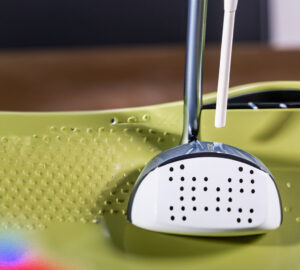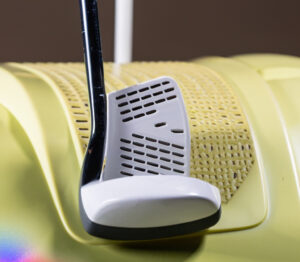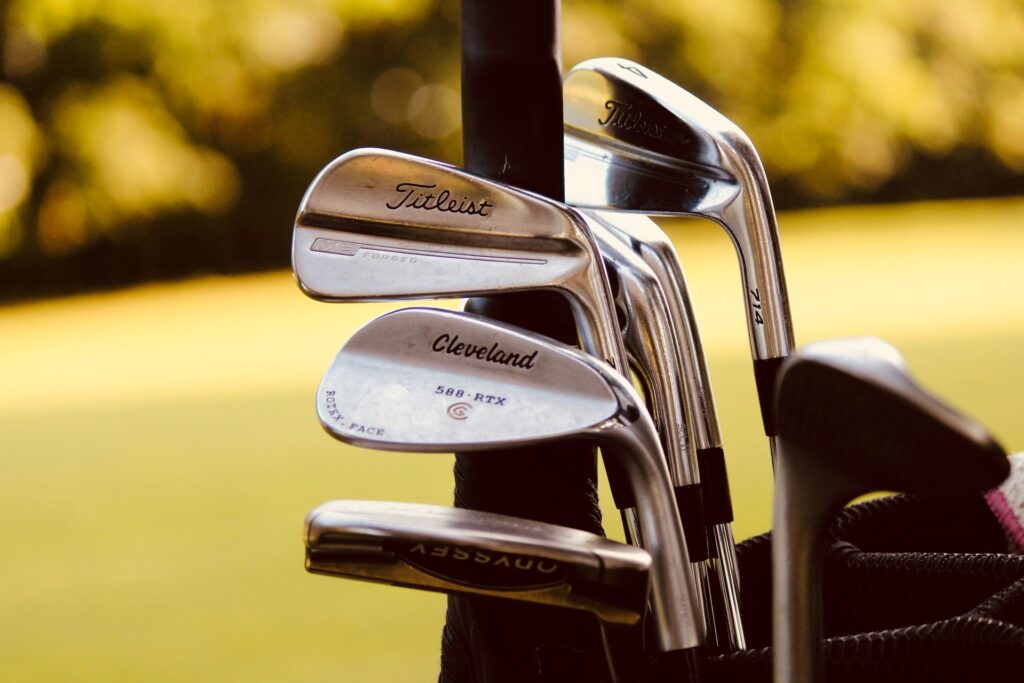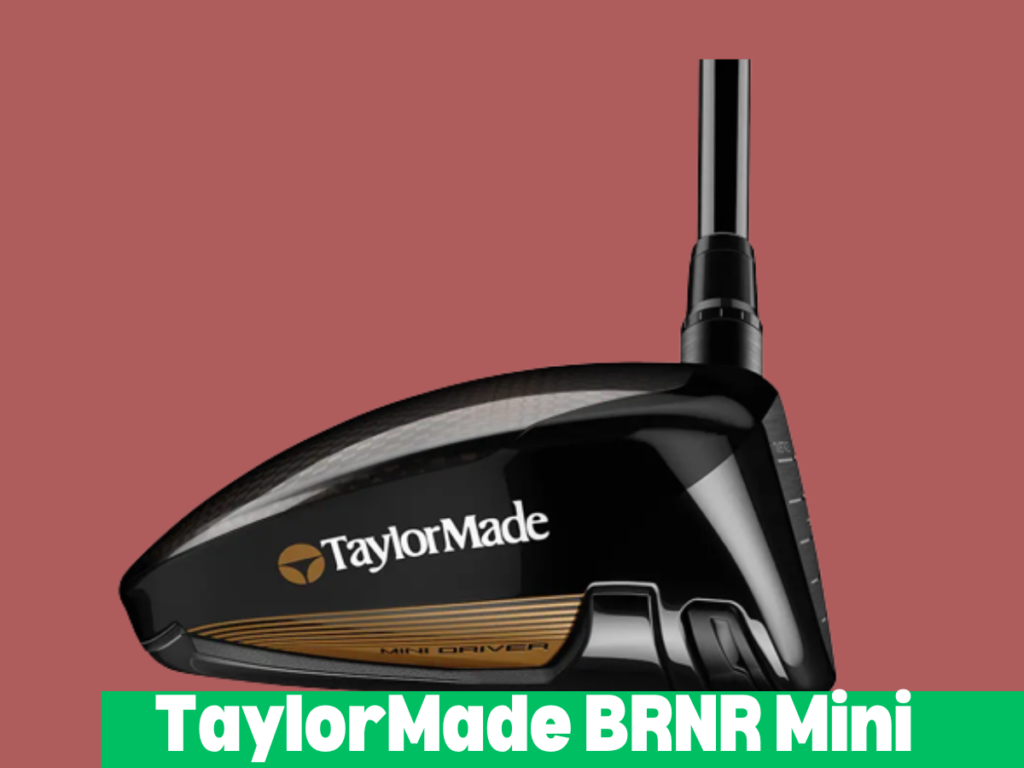Are you tired of struggling with your driver on the golf course? Do you want to add more accuracy and control to your game off the tee? Look no further than mini golf drivers.
These little powerhouses are quickly gaining popularity among golfers like yourself. With their smaller head and shorter shaft, mini drivers offer a controlled swing that can revolutionize your game.
Leading the pack in mini drivers is TaylorMade, known for their TaylorMade Original One Mini Driver. This club not only enhances accuracy and control but also helps correct slicing or hooking the ball. By allowing you to hit the center of the clubface more often, these mini drivers can even increase driving distance.
So get ready to experience a new level of confidence on the tee box and unlock new possibilities in your golf game with mini golf drivers.
Key Takeaways
- Mini golf drivers provide an alternative to strong three woods and are popular with golfers worldwide.
- The loft on mini golf drivers differs from traditional lofted drivers, with higher loft providing more forgiveness and a higher ball flight.
- Mini golf drivers usually have a smaller club head size, which may require adjustment for players.
- TaylorMade Mini Driver is considered the best mini driver on the market, maintaining clubhead speed and distance.
What are Mini Drivers?

Mini drivers, which are smaller in head size and have a shorter shaft than traditional drivers, are gaining popularity in golf as they offer a more controlled swing. Interestingly, the TaylorMade Original One Mini Driver is one example of a modern mini driver that can improve driving performance.
These mini-drivers provide several advantages for golfers looking to enhance their game off the tee. The smaller head size and shorter shaft allow for greater control over the clubface, resulting in more accurate shots. Additionally, mini drivers are designed to be forgiving on mishits, reducing the chances of slicing or hooking the ball.
Popular brands like TaylorMade have started producing mini-drivers to meet the growing demand from golfers who struggle with consistency off the tee. These mini drivers also offer various adjustability options, allowing players to fine-tune their launch angle and spin rate for optimal distance and accuracy. With these adjustability features, golfers can shape their shots according to course conditions and personal preferences.
Swing mechanics play an important role when using a mini driver. The smaller head size allows for increased swing speed without sacrificing control. Golfers can generate maximum power while maintaining a smooth tempo, resulting in longer drives down the fairway.
In summary, mini drivers provide golfers with numerous benefits such as increased control, forgiveness on mishits, adjustability options for shot shaping potential, and improved swing mechanics.
The rise of mini golf drivers
The concept of mini golf drivers was introduced by TaylorMade with their compact 300 Mini Driver. This club was designed to offer a blend of low center of gravity (CG) performance and high moment of inertia (MOI) forgiveness. The smaller clubhead size and shorter shaft length give golfers more control and accuracy, while still providing ample distance.
The rise of mini golf drivers can be attributed to several factors, including:
- Versatility: Mini drivers are designed to be powerful off the tee and playable off the deck. This versatility allows golfers to use the club in various situations, such as hitting narrow fairways or getting in good position on par 5s.
- Accuracy: The smaller clubhead size and increased loft of mini drivers make them more forgiving and easier to hit straight. This can help golfers find more fairways and improve their overall accuracy off the tee.
- Turf Interaction: Mini drivers have a shorter shaft length and a clubhead design that improves turf interaction. This makes it easier to hit the club off the deck, making it a great option for second shots on par 5s or for golfers who struggle with their normal driver.
Benefits and advantages of using mini golf drivers
Using a mini golf driver can provide several benefits and advantages for golfers, including:
- Improved Accuracy: The smaller clubhead size and increased loft of mini drivers make them more forgiving and easier to hit straight. This can help golfers find more fairways and improve their overall accuracy off the tee.
- Versatility: Mini drivers offer a unique combination of characteristics that make them suitable for various situations on the golf course. They can be used off the tee, off the deck, or for second shots on par 5s, providing golfers with added versatility in their game.
- Control: The shorter shaft length of mini drivers gives golfers more control over their swing and allows them to make more consistent contact with the ball. This can lead to improved ball striking and overall performance on the course.
- Increased Distance: Despite their smaller clubhead size, mini drivers can still provide ample distance off the tee. The combination of increased loft, shorter shaft length, and improved ball speed can help golfers achieve longer drives and improve their overall distance off the tee.
- Turf Interaction: The design of mini drivers allows for better turf interaction, making them easier to hit off the deck compared to traditional drivers. This can be beneficial for second shots on par 5s or for golfers who struggle with their normal driver.
Overall, mini golf drivers offer a unique combination of accuracy, versatility, control, and distance, making them a valuable tool for golfers looking to enhance their performance on the course.
Out Top Picks
| Mini Driver Model | Specs and Features | Performance and Playability | Amazon Price |
|---|---|---|---|
| TaylorMade 300 Mini | Right-handed club, Available in lofts of 11.5° and 13.5°, Head volume of 307cc, Club length of 43.5 inches, Swing weight of D3, Adjustability for loft and face angle | Impressive ball speed and forgiveness, Solid and quiet feel at impact, Versatile club for tee shots and shots off the deck | CLICK HERE |
| Honma Golf TR20 | Ultra-lightweight carbon fiber and high CIR Titanium construction, Vertical groove and variable face thickness for increased ball speed, Three adjustable weights | Improved distance and accuracy, Enhanced ball speed and forgiveness, Precise and stylish design | CLICK HERE |
| Ping G425 LST | Compact 445cc head size, Lower Spin Technology for reduced spin, Adjustable loft and lie options, CG Shifter with three positions | High forgiveness and stability, Lower spin for increased distance, Compact design for greater control | CLICK HERE |
| Titleist TSI 4 | Compact 425cc head size, Forward Center of Gravity (CG) for low spin, Improved MOI for stability, Adjustable loft and lie | Low spin property for penetrating ball flight, Improved distance and accuracy, Excellent workability and feel | CLICK HERE |
| Autopilot A14 | Length of 42.75 inches for consistent sweet spot hits, Zero Rotation Technology for square clubface, Player-friendly length, loft, and lie | Consistency and forgiveness on off-center hits, Increased distance and straighter drives, Improved control and accuracy off the tee | CLICK HERE |
Improved distance and accuracy

Experience greater distance and precision off the tee with the TaylorMade Original One mini driver, unleashing your full potential without sacrificing control or accuracy. The mini driver offers unique advantages over traditional drivers and 3-woods, allowing you to fine-tune your game like never before.
With different shaft options available, you can adjust the club to match your swing speed and launch conditions. This customization gives you the ability to optimize your distance control and shot shaping capabilities.
Compared to a 3-wood, the mini driver provides a larger clubhead size, which inspires confidence at address and enhances forgiveness on off-center hits. Its shorter shaft promotes a more controlled swing, helping you find the fairway more consistently. By adjusting your technique slightly, you can achieve optimal launch conditions for maximum distance.
The TaylorMade Original One mini driver is designed to give you both power and precision off the tee. Its innovative technology allows for better ball speed and increased carry distance while maintaining accuracy. Whether you’re facing a tight fairway or trying to avoid hazards, this mini driver will help you navigate any course with ease.
As we transition into discussing the impact of mini drivers on the overall golfing experience, it’s important to note that they can be a game-changer for players who struggle with their traditional driver. Not only do they offer improved distance and accuracy off the tee, but they also provide a sense of confidence and control that can transform your entire round of golf.
Impact on the overall golfing experience
Unleash the power of the TaylorMade Original One and witness a transformation in your game as you navigate the course with confidence, control, and newfound precision. Mini drivers have the ability to greatly impact your overall golfing experience.
As you step up to the tee box with a mini driver in hand, you’ll feel a surge of confidence knowing that you have a club designed specifically for accuracy and control. Compared to traditional drivers, mini drivers offer unique benefits that can enhance your game.
The smaller head size and shorter shaft of mini drivers make them easier to control and more forgiving on off-center hits. This means fewer slices or hooks and more accurate shots down the fairway. Mini driver technology has come a long way, with brands like TaylorMade leading the charge. The TaylorMade Original One is just one example of how mini drivers combine modern technology with improved performance. With its advanced features, such as adjustable loft settings and high-quality materials, this mini driver delivers impressive results.
Don’t just take our word for it – mini driver reviews from golfers worldwide rave about their improved accuracy and distance off the tee. However, it’s important to note that fitting is crucial when choosing a mini driver. Working with a professional fitter who can assess your swing characteristics will ensure that you find the perfect fit for maximum performance.
Adjusting to mini drivers may require some practice initially, but once you get comfortable with their unique characteristics, they can be a game-changer for your golfing experience. So why wait? Take advantage of the benefits offered by mini drivers and elevate your game today.
Adjusting to mini drivers
Get ready to revolutionize your game and conquer the course like never before – adjusting to these game-changing clubs will take your accuracy and control to new heights. Here are some techniques and drills to help you adjust to mini drivers:
- Start with a proper grip and setup: Make sure you have a solid grip and alignment at address. This will set you up for success with your mini driver shots.
- Practice shot selection: Mini drivers can be used off the tee or from the fairway, so practice selecting the right shot for each situation. Experiment with different lies and distances to find what works best for you.
- Customize your equipment: Adjusting the loft and weight settings on your mini driver can greatly impact its performance. Take the time to experiment with different settings to find the optimal combination for your swing.
- Address common misconceptions: Many golfers believe that mini drivers sacrifice distance for accuracy, but that’s not always the case. With proper technique, you can achieve both distance and accuracy with a mini driver.
- Incorporate practice drills: Work on hitting consistent shots by focusing on tempo, balance, and ball position. Use alignment aids or markers on the range to ensure you’re consistently hitting in the desired direction.
By mastering these adjusting techniques, practicing drill exercises, debunking common misconceptions about mini drivers, customizing your equipment, and making smart shot selections based on specific situations, you’ll be well-prepared to tackle any golf course challenge.
Now let’s move onto choosing the right loft for maximum performance…
Choosing the right loft

When it comes to mini drivers, one important factor to consider is choosing the right loft. The loft of a mini driver can greatly impact your performance and overall experience on the course. It’s crucial to find the loft that suits your swing speed and desired ball flight.
Swing speed plays a significant role in determining the appropriate loft for your mini driver. Generally, golfers with higher swing speeds tend to benefit from lower lofted drivers, as they produce a lower launch angle and less spin. On the other hand, golfers with slower swing speeds may find higher lofts more forgiving, as they generate a higher launch angle and more carry distance.
Once you’ve identified the optimal loft for your swing speed, you’ll need to adjust your technique accordingly. Mini drivers require slight adjustments compared to traditional drivers due to their smaller clubhead size and shorter shaft length. It’s essential to practice hitting balls with your mini driver until you feel comfortable with its unique characteristics.
By choosing the right loft and adjusting your technique, you’ll be able to achieve an ideal launch angle that maximizes both distance and accuracy off the tee. Now that we’ve covered this aspect of using mini drivers, let’s move on to some helpful tips for getting the most out of these versatile clubs.
Tips for using mini drivers
One helpful tip for using these versatile clubs is to experiment with different tee heights to find the optimal launch angle and maximize distance off the tee. Did you know that adjusting the tee height can affect the launch angle by as much as 2 degrees?
Here are four key tips to help you make the most of your mini driver:
- Adjusting Technique: When using a mini driver, it’s important to adjust your technique slightly compared to a traditional driver or 3-wood. Focus on making a smooth swing and keeping your tempo consistent.
- Tee Shot Strategy: With a mini driver, you have more control over your shots off the tee. Take advantage of this by strategically aiming for specific areas of the fairway or avoiding hazards altogether.
- Hitting Off the Deck: While mini drivers are primarily designed for use off the tee, they can also be effective when hitting off the deck. Practice hitting shots from fairway lies to gain confidence in using your mini driver in various situations.
- Minimizing Mishits: Mishits with a mini driver can still happen, but there are ways to minimize them. Stay focused on making solid contact with the center of the clubface and maintain good balance throughout your swing.
By adjusting your technique, strategizing your tee shots, practicing hitting off the deck, and minimizing mishits, you can optimize both distance and accuracy with your mini driver.
Now let’s move on to how to keep and maintain these valuable clubs…
Keeping and Maintaining Mini Golf Drivers
To ensure the longevity and performance of your mini driver, it’s crucial that you prioritize proper care and maintenance.
Mini drivers have made significant advancements in technology, allowing for greater customization and improved performance on the course.
To maintain the performance of your mini driver, it’s important to regularly clean the clubhead and shaft with a soft cloth or brush to remove any dirt or debris that may affect its performance. Additionally, check the grip for signs of wear and tear and replace it if necessary to ensure a secure hold during your swings.
Another aspect of maintaining your mini driver’s performance is taking advantage of its shot shaping capabilities. Mini drivers are designed to provide golfers with more control over their shots, allowing them to shape their ball flight as desired.
Experiment with different settings on your mini driver, such as loft adjustments or weight placement, to find the optimal configuration for your swing.
Lastly, consider getting fitted for your mini driver by a professional. A fitting guide can help determine the best specifications for your swing speed, launch angle, and spin rate. This will ensure that you are using a mini driver that is perfectly suited to your game.
By properly maintaining and utilizing the advanced features of your mini driver, you can maximize its performance on the course and take full advantage of its shot shaping capabilities.
Key factors to consider when choosing a mini golf driver
Driver Loft and Launch Angle
The loft of a mini golf driver plays a crucial role in determining the trajectory and distance of your shots. The loft refers to the angle of the clubface relative to the ground. It is essential to choose a driver with the right loft for your swing and desired ball flight.
A higher loft generally produces a higher ball flight, which can help with distance and accuracy for players with slower swing speeds. On the other hand, a lower loft promotes a lower ball flight and may be more suitable for players with faster swing speeds who are looking for extra distance.
It is crucial to find the right balance of loft that allows you to achieve your desired shot shape and trajectory. Experimenting with different lofts can help you find the optimal loft angle for your individual swing.
Shaft Flex and Length
Importance of Shaft Flex in Driver
Shaft flex refers to the ability of the shaft to bend during the swing. It plays a crucial role in the performance and feel of the driver. When choosing a mini golf driver, consider the following factors related to shaft flex:
1. Swing Speed: Your swing speed is a significant factor in determining the appropriate shaft flex. A player with a slower swing speed may benefit from a more flexible shaft to maximize distance and generate more launch. Conversely, a player with a faster swing speed may need a stiffer shaft for better control and accuracy.
2. Accuracy vs. Distance: The shaft flex can also affect your ability to control the direction of the ball. A more flexible shaft can provide more forgiveness and help correct slight inconsistencies in the swing, leading to better accuracy. On the other hand, a stiffer shaft may provide more distance but require a higher level of skill and consistency to control.
3. Feel: Shaft flex can significantly impact the feel of the driver. A player’s preference for a softer or stiffer feel largely depends on individual preferences and playing style. Some players may prefer a softer, more responsive feel, while others may prefer a firmer, more stable feel.
Optimal Driver Shaft Length for Mini Golf
The length of the driver shaft also plays a critical role in performance. Here are some factors to consider when determining the optimal driver shaft length for mini golf:
1. Control: A shorter driver shaft tends to provide better control and accuracy. It allows for a more compact and controlled swing, which can be beneficial when navigating obstacles and narrow fairways in mini golf.
2. Distance: While a shorter shaft may sacrifice some distance, it can still generate enough power for mini golf. The focus in mini golf is often on accuracy rather than distance, so finding the right balance between control and distance is essential.
3. Comfort: The driver shaft length should also be comfortable for you to swing consistently. Consider factors such as your height, arm length, and preferred stance when determining the optimal shaft length.
Remember, it’s essential to try out different shaft flexes and lengths to find the combination that suits your playing style and preferences. Consult with a professional golf club fitter for personalized recommendations based on your swing characteristics.
Head Size and Weight

When choosing a mini golf driver, it’s important to consider the head size and weight. These factors can greatly impact your ability to achieve forgiveness and distance with your shots.
Effects of Head Size on Forgiveness and Distance
The head size of a mini golf driver can vary, typically ranging from 2 to 4 inches in diameter. The larger the head size, the more forgiving and easier it is to hit the ball consistently. Larger head sizes have a larger sweet spot, which is the area on the clubface that produces the optimal contact with the ball. This means that even if you slightly mis-hit the ball, you’re more likely to achieve good distance and accuracy with a larger head size.
On the other hand, smaller head sizes can offer more control and precision, but they require better accuracy in order to make solid contact with the ball. They may be preferred by experienced players who have developed a consistent swing and are confident in their ability to make precise shots.
Finding the Right Weighted Driver Head
The weight of the driver head also plays a significant role in your performance on the mini golf course. The weight of the driver head affects the speed, distance, and control of your shots.
- A heavier driver head can generate more power and distance, but it may require more strength and effort to swing. It’s commonly used by players who have a faster swing speed and are looking for maximum distance off the tee.
- A lighter driver head, on the other hand, can help you increase your swing speed and generate more clubhead speed. This can lead to increased distance, especially for players with a slower swing speed. It may also be easier to control and maneuver for players who prioritize accuracy over distance.
It’s important to find the right balance between head size and weight that suits your swing style and skill level. Consider factors such as your strength, swing speed, and personal preferences when deciding on the ideal head size and weight for your mini golf driver.
With the right combination of head size and weight, you can optimize your performance and improve your scores on the mini golf course. Take the time to test out different options and find the driver that feels comfortable and enhances your game.
Adjustability and Customization
One key factor to consider when choosing a mini golf driver is the level of adjustability it offers. Adjustable drivers have become increasingly popular as they provide players with the ability to fine-tune their shots and optimize their performance. Some benefits of adjustable drivers include:
1. Distance Control: With an adjustable driver, you can experiment with loft and face angle settings to find the optimal combination that maximizes distance and control for your swing.
2. Shot Shaping: Adjustability allows you to change the driver’s settings to promote a draw or fade, enabling you to shape your shots and navigate around obstacles on the mini golf course.
3. Trajectory Control: By adjusting loft and launch angle, you can control the trajectory of your shots, making it easier to clear obstacles or hit approach shots accurately.
4. Personalized Feel: Adjustability gives you the ability to customize the driver to match your swing and feel more comfortable and confident on the course.
Ball Speed and Moment of Inertia (MOI)
Impact of Ball Speed on DistanceWhen choosing a mini golf driver, ball speed is a key factor to consider. The faster the ball speed, the greater the distance it can travel. A driver with higher ball speed will allow you to generate more power and achieve longer shots on the mini golf course. It is important to look for a driver that is designed to maximize ball speed, allowing you to hit the ball farther and score better on the course.
Importance of High MOI for Forgiveness
In addition to ball speed, the moment of inertia (MOI) is another crucial factor to consider when choosing a mini golf driver. MOI refers to the clubhead’s resistance to twisting upon impact with the ball. A driver with high MOI provides forgiveness and stability, even on mishits. This means that even if you don’t hit the ball perfectly, a high MOI driver will help keep the ball on target and minimize the distance loss. Look for a mini golf driver with a high MOI to enhance your accuracy and consistency on the course.
Spin Rate and Trajectory
Controlling Spin Rate for Accuracy
Spin rate is a crucial factor to consider when choosing a mini golf driver. The spin rate refers to the amount of backspin or topspin that the ball has after being hit. Here are a few key points to keep in mind:
- Distance Control: A lower spin rate can help reduce the amount of sidespin on the ball, resulting in straighter shots and better distance control.
- Accuracy: Higher spin rates can create more backspin, which can cause the ball to stop quickly upon landing. This can be beneficial when trying to hit the ball close to the hole, especially on elevated or fast greens.
- Wind Conditions: Understanding the spin rate can help you adjust your shot to compensate for windy conditions. A higher spin rate can help the ball hold its line better against the wind.
- Feel and Control: Different players have different preferences when it comes to feel and control. Some players may prefer a driver with a higher spin rate for better feel and shot shaping abilities, while others may prefer a lower spin rate for more forgiveness and consistency.
Desired Trajectory for Mini Golf Shots
The trajectory of the golf ball refers to the flight path it takes from the moment it leaves the clubface until it lands. Here are a few factors to consider when choosing a mini golf driver:
- Launch Angle: The launch angle is the angle at which the ball takes off from the clubface. A higher launch angle can help maximize distance and carry, while a lower launch angle can result in a lower, more penetrating ball flight.
- Ball Flight: The ball flight can be influenced by factors such as loft, clubhead speed, and shaft flex. Understanding your desired ball flight can help you choose a driver with the appropriate characteristics.
- Shot Shape: Different players have different shot shapes, such as a fade or draw. Some drivers are designed to promote a specific shot shape, while others offer adjustability to cater to individual preferences.
- Accuracy: Finding a driver that allows you to consistently hit your desired trajectory can lead to improved accuracy and shot dispersion.
By considering factors such as spin rate and trajectory, you can choose a mini golf driver that suits your playing style and helps you achieve your desired results on the course.
Budget and Price Range
When choosing a mini golf driver, it’s important to consider your budget and price range. Before you start looking at different drivers, take some time to determine how much you are willing to spend. Knowing your budget will help narrow down your options and prevent you from overspending.
Here are a few factors to consider when determining your budget:
- Your skill level: If you’re a beginner or occasional mini golfer, you may not need to invest in an expensive driver. Opting for a mid-range or budget-friendly option might be more suitable.
- Frequency of use: If you plan on playing mini golf frequently, it might make sense to invest in a higher-quality driver that will last longer and provide better performance.
- Personal preferences: Consider how important mini golf is to you and how much you’re willing to invest in your equipment. Some players prioritize having the best-quality gear, while others are more focused on enjoying the game without breaking the bank.
Conclusion
So, now that you know all about mini golf drivers, it’s time for you to hit the course and give one a try. These little powerhouses can truly revolutionize your game.
With their smaller heads and shorter shafts, they offer more control and accuracy off the tee. And don’t forget about the increased distance they can provide!
So grab a TaylorMade Original One Mini Driver or another top-notch option, adjust your swing, and watch your ball soar down the fairway with precision.
It’s time to step up your golf game and embrace the mini-driver revolution!
Frequently Asked Questions
How do mini drivers differ from traditional drivers and 3-woods?
Mini drivers differ from traditional drivers and 3-woods in several ways. Mini driver technology allows for better distance control, while also providing advantages such as forgiveness and accuracy. The shorter shaft and smaller head size of mini drivers make them easier to swing with more control. Compared to traditional drivers, mini drivers offer similar performance but with increased accuracy and precision.
What are some tips for adjusting to using a mini driver?
To adjust to using a mini driver, start by adjusting your grip to accommodate the shorter shaft. Focus on maintaining smooth swing mechanics and tempo to maximize control. Experiment with tee height for optimal launch angle. Practice shot shaping techniques and develop distance control strategies through consistent practice.
How do mini drivers impact overall distance and accuracy?
Using a mini driver can have a significant impact on your distance and accuracy. It’s like adding a precision tool to your golf bag. The advantages include improved swing mechanics, better control, and the ability to hit straighter shots. Don’t be fooled by misconceptions – mini drivers are not hybrids, but they offer similar benefits. However, keep in mind that using a mini driver in different weather conditions may have pros and cons due to factors like wind resistance or wet turf.
What is the impact of using a mini driver on the overall golfing experience?
Using a mini driver can have a significant impact on your overall golfing experience. The technology in these drivers provides benefits such as increased accuracy, improved distance, and the ability to hit straighter shots. Contrary to common misconceptions, mini drivers are not just for beginner golfers. They offer a more controlled swing compared to hybrids and can be beneficial for players of all skill levels. So if you’re looking to enhance your game and gain more confidence on the tee box, consider giving a mini driver a try.
How do you choose the right loft for a mini driver?
To choose the right loft for a mini driver, consider its technology and how it affects launch angle. Higher lofts provide more forgiveness and a higher ball flight, while lower lofts are better for high swing speeds. Experimenting with different loft angles can help optimize your mini driver’s performance.

I’m Donna Weiss, and I am the proud writer behind the captivating content you’ll find on golfneedy.com. As an avid golfer and passionate writer, I have combined my two greatest passions to bring you an incredible golfing experience. Through my articles, I aim to provide you with valuable insights, equipment reviews, and updates on the latest tournaments. Whether you’re a seasoned golfer or just starting out on this exciting journey, I am here to guide you and share my expertise. Together, let’s explore the fascinating world of golf, uncovering new techniques, and enhancing our skills. Join me on this thrilling adventure as we elevate our game and embark on an exciting golfing journey. Read More



